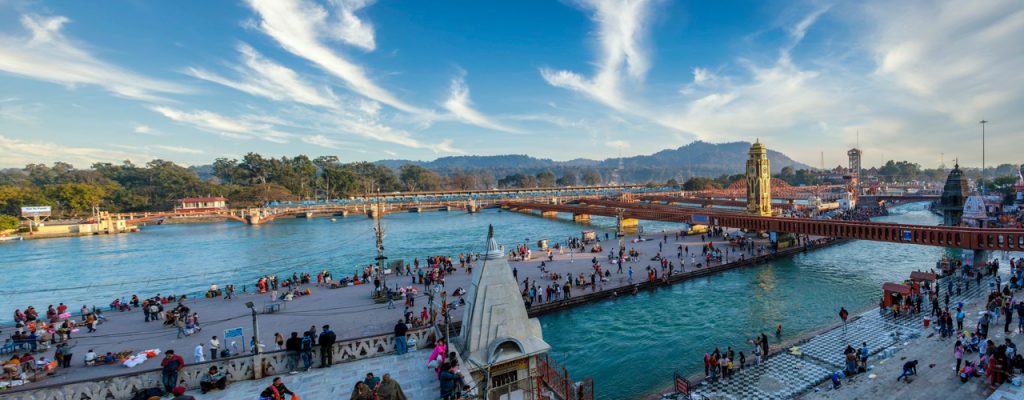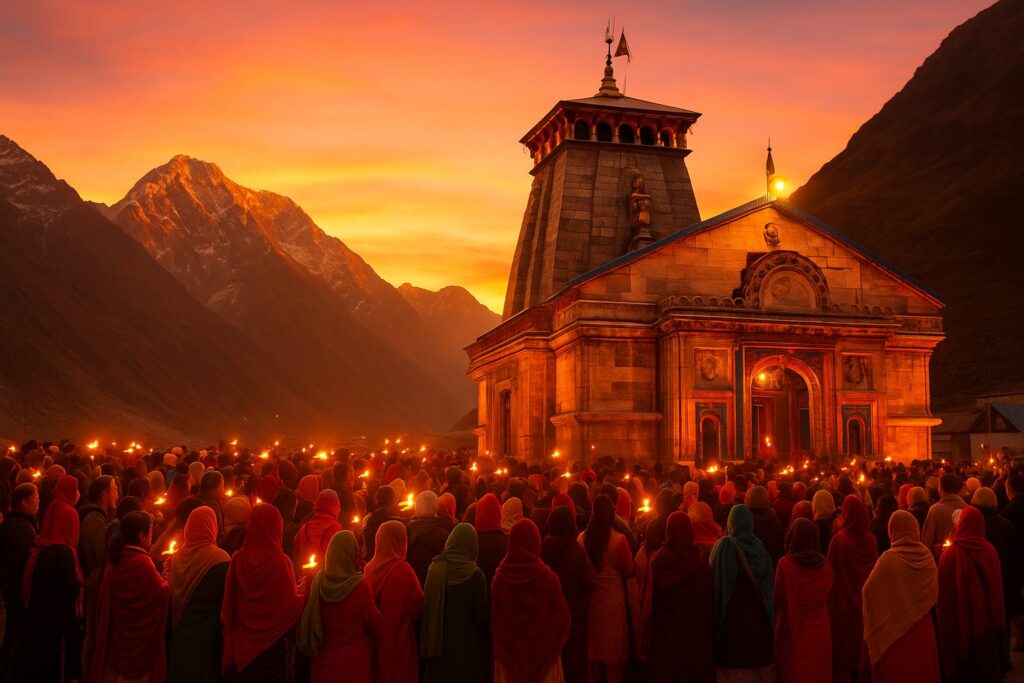Kedarnath and Badrinath: Ultimate Spiritual Journey to India’s Sacred Himalayas
Tucked away in the majestic Garhwal Himalayas of Uttarakhand, India, lie two of the most sacred pilgrimage sites in Hinduism—Kedarnath and Badrinath. These shrines are not only spiritual powerhouses but also testaments to India’s ancient culture, architectural brilliance, and breathtaking natural beauty. Both form part of the revered Char Dham Yatra, a journey every devout Hindu aspires to undertake in their lifetime.
KEDARNATH – The Abode of Lord Shiva
Location:
Kedarnath is located at an altitude of 3,583 meters (11,755 feet) above sea level, near the Mandakini River, in the Rudraprayag district of Uttarakhand. Surrounded by snow-capped peaks and alpine forests, it is one of the most remote yet spiritually significant places in India.
Historical and Mythological Significance:
Kedarnath is one of the 12 Jyotirlingas of Lord Shiva and holds a central place in Shaivism. According to mythology, after the Mahabharata war, the Pandavas sought penance for killing their kin. Lord Shiva, avoiding them, disguised himself as a bull and disappeared into the earth. His hump appeared in Kedarnath, which became the site of the temple. Other parts of the body are believed to have surfaced at other Panch Kedar sites.
The temple is believed to have been originally built by the Pandavas, and later revived by Adi Shankaracharya in the 8th century CE. The present structure, made of massive stone slabs, has withstood the test of time and nature—including the catastrophic 2013 floods.
️ The Journey to Kedarnath:
Reaching Kedarnath is a spiritual adventure in itself. The journey involves:
- A drive up to Gaurikund, the base for the trek.
- A 21 km steep trek to the temple. For those unable to walk, options like pony rides, palkis (palanquins), and helicopters are available.
The trail is lined with picturesque views of the Himalayas, waterfalls, pine forests, and glimpses of sadhus and pilgrims chanting Shiva’s name.
The Temple Experience:
Entering the temple complex, you’re met with an aura of serenity and power. The sanctum houses the cone-shaped Shiva lingam, representing the deity’s hump. Devotees offer prayers, flowers, and bilva leaves. The atmosphere, filled with the echo of bells and chants of “Har Har Mahadev,” instills a deep spiritual connection.
Best Time to Visit:
The temple is open from April/May to October/November, depending on the weather. It remains closed in winter due to heavy snowfall. During the closure, the deity is moved to Omkareshwar Temple in Ukhimath.
BADRINATH – The Abode of Lord Vishnu
Location:
Situated at an elevation of 3,300 meters (10,827 feet), Badrinath lies between the Nar and Narayan mountain ranges, along the banks of the Alaknanda River in Chamoli district, Uttarakhand.
Mythological and Historical Importance:
Badrinath is dedicated to Lord Vishnu, who is worshipped here in his Badri form. Legend says that Vishnu meditated here under a Badri tree (wild berry tree), and Goddess Lakshmi protected him from harsh weather by turning into a tree herself. Hence, the place came to be known as Badrinath.
It is one of the 108 Divya Desams (sacred Vishnu temples mentioned in Tamil literature) and the only one in the north. Like Kedarnath, the present temple was also revived by Adi Shankaracharya, though the idol is believed to date back to the Vedic period.
The Temple Architecture:
The Badrinath Temple, with its bright facade of red and yellow, resembles a Buddhist monastery—a reflection of the region’s diverse cultural influences. Inside the sanctum, the main idol of Lord Vishnu in a meditative posture is carved in black Shaligram stone. It’s flanked by idols of Nar, Narayan, and other deities.
Tapt Kund and Other Attractions:
Just before entering the temple, pilgrims take a holy dip in the Tapt Kund, a hot water spring believed to have healing powers. Other important sites around Badrinath include:
- Mana Village: The last village before the Indo-China border.
- Vyas Gufa: Where Ved Vyasa is said to have composed the Mahabharata.
- Bheem Pul: A natural stone bridge said to be placed by Bheem for Draupadi.
Best Time to Visit:
Like Kedarnath, Badrinath is also open from May to November. In winters, the idol is moved to Joshimath, where it is worshipped for six months.
Kedarnath and Badrinath: Differences and Unity
| Aspect | Kedarnath | Badrinath |
|---|---|---|
| Deity | Lord Shiva | Lord Vishnu |
| Altitude | 3,583 m | 3,300 m |
| Location | Rudraprayag District | Chamoli District |
| Architectural Style | Stone temple in Nagara style | Colorful facade with Garhwali and Buddhist influence |
| Trek Required | Yes, 16 km | No, accessible by road |
| Temple Opening | April/May to October/November | May to November |
Despite their differences, both temples symbolize the unity of Shaivism and Vaishnavism, and are often visited together in the Do Dham Yatra.
Travel Tips for Pilgrims and Travelers
- Fitness: For Kedarnath especially, basic physical fitness is important. Begin light exercise weeks before your trip.
- Altitude Sickness: Acclimatization is key. Carry necessary medication for high-altitude symptoms.
- Clothing: Pack warm clothes, even in summer. Weather can change rapidly in the mountains.
- Registration: Pilgrims need to register online before embarking on the Char Dham Yatra.
- Respect the Sanctity: Both places are deeply spiritual. Avoid loud behavior, photography inside sanctums, or polluting the environment.
- Book Early: Especially during peak seasons (May-June, September), accommodations and helicopter services get booked fast.
In Conclusion
Kedarnath and Badrinath are not just temples—they are living symbols of faith, standing resilient amidst the harshest of natural landscapes. A visit here is a journey inward, into one’s own spirit and beliefs. Whether you’re a devout pilgrim or a seeker of peace, these shrines offer a divine experience unlike any other.
The Himalayan air, the chants, the mythological grandeur, and the sheer isolation from modern chaos make Kedarnath and Badrinath truly sacred destinations of the soul.
Kedarnath and Badrinath
Do Dham” refers to the two most sacred and revered Hindu pilgrimage sites in the Indian state of Uttarakhand, namely Kedarnath and Badrinath.
Kedarnath is located in the northern part of Uttarakhand, in the Mandakini Valley near the head of the river Mandakini. It is one of the four major shrines in the Indian Himalayas and is dedicated to Lord Shiva. The temple is believed to have been built by the Pandavas during the Hindu epic, Mahabharata.
Badrinath, on the other hand, is situated in the Chamoli district of Uttarakhand, along the banks of the Alaknanda River. It is one of the “Char Dhams” (four sacred shrines) and is dedicated to Lord Vishnu. The temple is believed to have been established by the Hindu saint, Adi Shankaracharya, in the 8th century AD.
Both Kedarnath and Badrinath are considered to be among the most sacred places for Hindu pilgrims and are visited by thousands of devotees every year. The journey to these shrines is considered to be both physically and spiritually challenging,but it is believed that the blessings and peace that one receives from these shrines make it all worth it.
Major Sightseeing: –
- Devparyag (sangam/confluence)
- Rudraparyag (sangam/confluence)
- Karanparyag (sangam/confluence)
- Vishnuprayag (sangam/confluence)
- Nandprayag (sangam/confluence)
- Ardhnareshwar temple & Manikarkund Temple.
TOUR ITINERARY

Day 01: Haridwar – Guptkashi (250kms/8 hrs)
Your yatra is going to start from haridwar railway station. It will go to guptkashsi first. You’ll gonna see first, the great and famous temple of Kali maiyaan “DharaDevi temple” enroute which is in the middle of alaknanda river at kalyasour at the route of Srinagar. The destinations, Guptkashi,Vishwanath temple, Ardhnareshwar temple & Manikarkund where the two streams of river ganga and yamuna are believed to meet. Check in to the hotel. Overnightstay at hotel.
Day 02: Guptkashi –Sersi/Phata (Helipad)/ Sonprayag
After breakfast check out from hotel, then drop to Sonprayag (for trek route) trek starts from here to Kedarnath Ji. Start to ascend on trek route either by walk or pony/doli (at own cost). Helicopter service is also available for Kedarnath, so one can take helicopter to Kedarnath (at own cost). Tour members should carry personal medicines, heavy woolen, toiletries and clothes. After performing Pooja & Darshan of Shri Kedarnath Ji. Overnight stay at GMVN Dormitory at Kedarnath.
Day 03: Kedarnath – Sonprayag/Sersi/Phata-Ukhimath-Chopta (55 Kms / 03 hrs)
Morning Kedarnath Ji Darshan then move to walk trek 16k.m. down reach sonprayag and sersi/Phata by Helicopter, then our Vehicle pick up you and then drive to Ukhimath/chopta. En the route you can see Omkareshwar Temple in Ukhimath, check in to the hotel. Overnight stay at Hotel.
Day 04: Chopta – Badrinath (160 kms /08hrs)
After breakfast check out from hotel, then drive to the hotel to Badrinath, en route you can see Nar sing Devta temple in Joshimath then go to Badrinath and check in to the hotel rest and relaxes at Hotel. Overnight stay at hotel.
Day 05: Badrianth – Rudraprayag (160 Km/ 07 Hrs)
Early morning visit Badrinath Ji darshan attend pooja then back to hotel, breakfast then check out from hotel, drive to Mana. There is another interesting sightseeing spot like Mana, Vyas Gufa and Bhimkund and the “Mukh” of the Saraswati River. Just within the three km of Badrinath ji.Then drive to Rudraprayag, arrival at Rudraparyag, check in to the Hotel, rest n relax. Overnight stay at hotel.
Day 06: Rudraprayag – Haridwar (160 Km/7Hrs)
After morning breakfast check out from hotel, and then drive to Haridwar, en route you can see Devprayag, Rishikesh then drop at Haridwar. Check in to the Hotel, rest n relaxes. Overnight stay at hotel.
FAQs: Kedarnath and Badrinath
1. What is the significance of Kedarnath Temple?
Answer:
Kedarnath Temple is one of the 12 Jyotirlingas of Lord Shiva and a vital part of the Char Dham Yatra. It is believed to be the place where Lord Shiva appeared in the form of a bull to bless the Pandavas after the Mahabharata war. The temple is also known for its remote Himalayan location and ancient stone architecture.
2. Why is Badrinath Temple famous?
Answer:
Badrinath Temple is dedicated to Lord Vishnu and is one of the 108 Divya Desams, as well as a key site in the Char Dham Yatra. Located in the Chamoli district of Uttarakhand, it is believed to be the place where Lord Vishnu meditated under a Badri tree, protected by Goddess Lakshmi.
3. How can I reach Kedarnath and Badrinath?
Answer:
To reach Kedarnath, you must travel to Gaurikund by road, followed by a 16 km trek or a helicopter ride. Badrinath is accessible by road and lies on the NH-58 route. Both sites are well connected from Rishikesh, Haridwar, and Dehradun.
4. What is the best time to visit Kedarnath and Badrinath?
Answer:
The best time to visit both temples is between May and early November, during the Char Dham Yatra season. The temples remain closed in winter due to heavy snowfall and reopen in the spring.
5. Can I visit Kedarnath and Badrinath in one trip?
Answer:
Yes, many pilgrims undertake the Do Dham Yatra, which includes both Kedarnath and Badrinath. Typically, the route follows a visit to Kedarnath first, followed by Badrinath. The journey can take 5–7 days depending on your itinerary and travel method.
6. Are helicopter services available for Kedarnath?
Answer:
Yes, helicopter services are available from places like Phata, Guptkashi, and Dehradun to Kedarnath during the open season. It’s a popular option for senior citizens and those unable to trek.
7. Do I need to register for the Kedarnath-Badrinath Yatra?
Answer:
Yes, registration is mandatory for all pilgrims visiting Kedarnath, Badrinath, and other Char Dham sites. You can register online through the official Uttarakhand tourism website or at various registration counters en route.
8. What should I carry during the Kedarnath-Badrinath trip?
Answer:
You should carry warm clothes, a medical kit, ID proof, rain gear, trekking shoes (for Kedarnath), sunscreen, energy snacks, and your Yatra registration slip. Mobile networks are limited in some areas, so plan accordingly.
9. Are accommodations available near Kedarnath and Badrinath?
Answer:
Yes, there are plenty of guesthouses, dharamshalas, government rest houses, and private hotels near both temples. However, booking in advance is recommended, especially during peak season.
10. Is the Char Dham Yatra safe?
Answer:
Yes, the Char Dham Yatra is generally safe, but the routes, especially to Kedarnath, can be physically demanding due to high altitude and weather conditions. Pilgrims are advised to undergo health checkups, carry essentials, and follow government advisories.
More Information Contact: https://charbhujatravels.in/contact/

